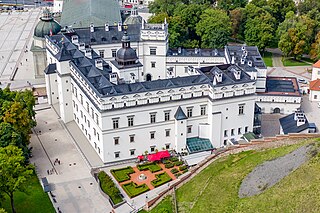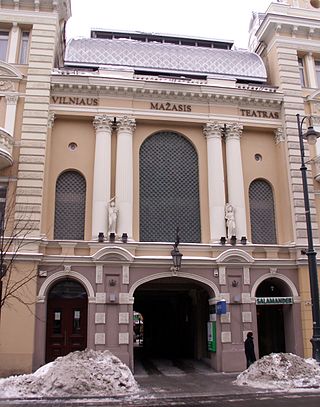
Vilnius is the capital of and largest city in Lithuania and the second-most-populous city in the Baltic states. The city's estimated July 2024 population was 605,270, and the Vilnius urban area has an estimated population of 708,627.

Music of Lithuania refers to all forms of music associated with Lithuania, which has a long history of the folk, popular and classical musical development. Music was an important part of polytheistic, pre-Christian Lithuania – rituals were accompanied by music instruments and singing, deeds of the heroes and those who didn't return from the war were celebrated in songs.

Mikalojus Konstantinas Čiurlionis was a Lithuanian composer, painter, choirmaster, cultural figure, and writer in Polish.

Regimantas Adomaitis was a Lithuanian film and stage actor. He was also active in Russia and Germany.

The Palace of the Grand Dukes of Lithuania is a palace in Vilnius, Lithuania. It was originally constructed in the 15th century for the rulers of the Grand Duchy of Lithuania and the future Kings of Poland. The palace, located in the lower castle of Vilnius, evolved over the years and prospered during the 16th and mid-17th centuries. For four centuries the palace was the political, administrative and cultural centre of the Polish–Lithuanian Commonwealth. It was demolished in 1801.

Lithuania attracts many visitors from neighbouring countries and from all over the world. In 2018,there were 1.7 million foreign visitors to Lithuania for business, family and leisure. The historical legacy of the Grand Duchy of Lithuania, its rich history, architecture, pristine nature, seaside and spa resorts are the main attraction points of Lithuania. Domestic tourism is also highly popular: in 2018 it grew by 12%. Lithuanians also prefer to spend their vacations in Lithuania – 70 percent.
Daina Society was a Lithuanian cultural organization promoting Lithuanian folk traditions and songs. It was established as an illegal cultural society by the composer Juozas Naujalis and officially registered with the Tsarist authorities in 1905. Active from 1899 to 1944 in Kaunas, the society organized various events, concerts, amateur theater performances. In 1924, it initiated the first Lithuanian Song Festival.

The Lithuanian Academy of Music and Theatre in Vilnius, Lithuania, is a state-supported conservatory that trains students in music, theatre, and multimedia arts.

Lithuanian National Museum of Art is the largest national museum in Lithuania collecting, restoring, and conserving art as well as historical objects of cultural value while presenting artefacts of national importance in an astonishing number of exhibition spaces located in the coastal cities and the capital.

Antanas Žmuidzinavičius was a Lithuanian painter and art collector.
Robertas Antinis is a Lithuanian Sculptor, performance artist and poet. He is a winner of the National Culture and Art Prize.

Ilja Bereznickas is a Lithuanian animator, illustrator, scriptwriter and caricaturist.

Plungė Manor is a former Ogiński family residential manor in Plungė, Lithuania. It now harbors the Samogitian Art Museum.

Vytenis Jankūnas is a Lithuanian-American artist living and working in New York City. His work consists of photographs, paintings and mixed media works.

Grytė Pintukaitė is a Lithuanian portrait painter, member of the Lithuanian Artists' Association, and member of the Association LATGA - Lithuanian Copyright Society.

Rūta Society was a Lithuanian cultural society in Vilnius, then part of the Russian Empire, active from 1909 to the outbreak of World War I in 1914. It organized various events, including lectures, literary evenings, and musical performances, but it is most noted for its contribution to the development of the Lithuanian theater. In total, Rūta staged about 50 plays.

The MO Museum is a modern art museum in Vilnius, Lithuania. As a private initiative of Lithuanian scientists and philanthropists Danguolė Butkienė and Viktoras Butkus, it functioned as an art museum without walls for about ten years. The collection of 6,000 modern and contemporary pieces contains major Lithuanian artworks from the 1950s to the present day.

The Museum of Antiquities in Vilnius was a museum of archaeology and history established by Count Eustachy Tyszkiewicz in 1855 at the premises of the closed Vilnius University. It was the first public museum in the former Grand Duchy of Lithuania and is considered a predecessor of the National Museum of Lithuania even though only a handful of items from the Museum of Antiquities ended up at the National Museum. Together with the Archaeological Commission which functioned as a de facto learned society, the museum was the most prominent cultural and scientific institution in all of Lithuania and displayed many historical items that reminded of the old Grand Duchy and served romantic nationalism of Lithuanian nobles at the time when Lithuania was part of the Russian Empire. The museum collections rapidly grew to over 67,000 items in 1865 by absorbing large collections of minerals and zoological specimens from the closed Vilnius University, libraries of various closed Catholic churches and monasteries, and various donations from local nobles.

Minor Radvilos Palace is a former palace of the Radziwiłł family in Vilnius, Lithuania. The palace was originally built in the 17th century and was reconstructed twice in 1796–1810 and 1987–1989. Currently, it houses the Lithuanian Theater, Music and Cinema Museum.

The Lithuanian Art Society was a society that organized Lithuanian art exhibitions and supported Lithuanian artists. Based in Vilnius, it was active from 1907 to the outbreak of World War I in 1914. It was chaired by painter Antanas Žmuidzinavičius. The society was established after the first Lithuanian art exhibition was successfully organized in early 1907. The society continued to organize annual exhibitions that displayed works both by professional and folk artists. Influenced by the Arts and Crafts movement, the society paid great attention to Lithuanian folk art which was increasingly seen as an expression of the Lithuanian character. In 1912, the society published an album of drawings of Lithuanian crosses, column shrines, and roofed poles, which is considered the first study of Lithuanian folk art. The society was also instrumental in preserving the art of Mikalojus Konstantinas Čiurlionis and organized his first solo exhibitions in 1911 and 1913. The society also collected works by other artists and worked with the Lithuanian Scientific Society to establish a Lithuanian art museum. The collection was transferred to the present-day M. K. Čiurlionis National Art Museum in 1920.






















